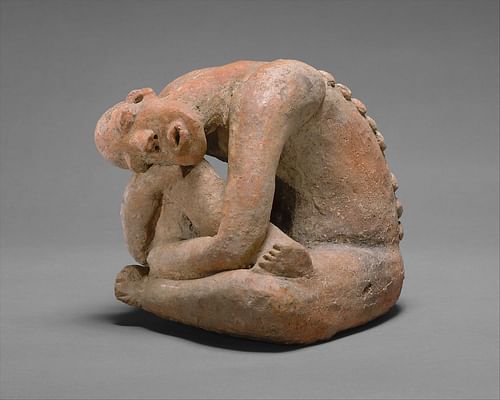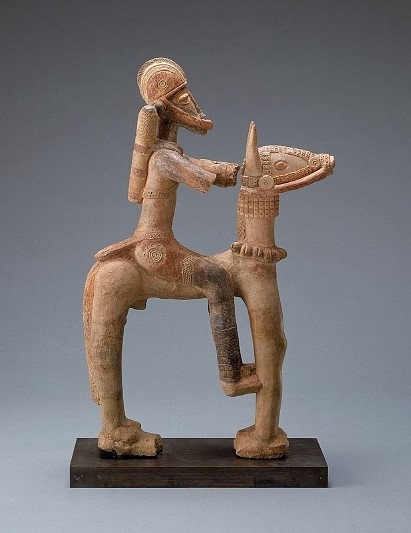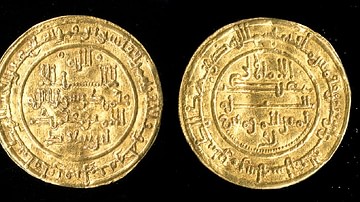
Djenne-Djenno (aka Djenné-Jeno, Jenne-Jeno, or Old Jenne) was an ancient city located in modern Mali, West Africa which flourished between c. 250 BCE - 1100 CE, making it one of the oldest cities in Sub-Saharan Africa. Prospering thanks to fertile agricultural land and as a hub of regional trade, the city boasted a population of around 20,000 at its peak. Djenne-Djenno, along with its medieval namesake city nearby, has been listed as a UNESCO World Heritage Site since 1988 CE.
Location & Geography
Djenne-Djenno or Old Djenne (to distinguish it from the later medieval town of that name) is located on the floodplain of the Inland Niger Delta. It is 130 kilometres (80 miles) southwest of the modern city of Mopti in Mali and 3 kilometres (1.9 miles) from Djenne. The settlement dates to at least the 3rd century BCE, and its people prospered thanks to the plentiful fish in the Niger River and its tributaries, channels, and lakes. The river also brought alluvial deposits to enrich the land of the area, making it possible to farm intensively. Consequently, two crops a year were grown which included cereals, African rice, vegetables (e.g. chillies and onions), and fruit.
The city grew even more prosperous thanks to its location at the junction of the Niger River and land routes which connected trade passing to and from the Sahara desert and Sudan savannah region in the north to the forests in the south. Local trade involved the movement of the foodstuffs mentioned above as well as dried fish and fish oil. By the end of the 3rd century CE, Djenne-Djenno traders were even more ambitious and could now import stones to be used as grindstones and iron ore and copper for metalworking. Iron-smelting technology allowed for the production of more efficient tools and weapons. By the 6th century CE, exports now included locally-made pottery (examples have been found 750 km or 465 miles to the north), perhaps exchanged for salt, glass beads, and gold.
A Thriving City
Djenne-Djenno had a population of around 20,000 in the 6th-9th century CE and covered some 300,000 square metres. The city may have been the centre of a wider state or kingdom, and there is evidence of perhaps 15 smaller surrounding settlements, some separated from each other only by a few hundred metres. However, any political apparatus has not and perhaps cannot be revealed by archaeology alone in the absence of a writing system. Certainly, the size of the city was exceptional, even by today's standard in the region and some sort of centralisation is indicated by the presence of specialised workshops for potters and metalworkers in some of the city's surrounding mini-settlements.
The city went into a gradual decline from the 9th century CE and was ultimately replaced as the local trade terminus by the new city of Djenne, which was founded in the 13th century CE by Muslim traders. Djenne-Djenno was then all but abandoned for unknown reasons in the 14th century CE, perhaps because the new Muslim religion required a site without a pagan history or, as recorded in oral traditions, the population of Djenne-Djenno had simply outgrown the city. Whatever caused its demise, the city had shown the way for successive empires that similarly exploited the trade possibilities of West Africa such as the Ghana Empire (6th-13th century CE), Mali Empire (1240-1645 CE), and Songhai Empire (1460-1591 CE).
Archaeological Remains
Excavations at the site, largely carried out by Susan and Roderick McIntosh over three decades, have revealed that the city had a surrounding wall made of mud bricks, constructed c. 800 CE. The wall is not considered a defensive fortification. No large buildings that may have functioned as palaces or temples have been discovered as yet. There are remains of houses which have a circular ring of stone foundations for the walls which would have been made of dried mud and have since disappeared.
The finest of Djenne-Djenno's pottery is decorative and not only functional. The wares are painted in various colours and given further decoration by incising geometric patterns and cross-hatching or pressing pieces of woven twine onto the outer surface before firing. Gold jewellery pieces have been found as well as objects made locally using both copper and bronze, and a small number of glass beads, most likely from India and brought to the city by trans-Saharan camel caravans.
Amongst the most interesting finds at Djenne-Djenno are terracotta sculptures. These often depict a bearded male figure, sometimes helmeted and carrying weapons, usually riding a horse. There are no representations of what may be identified as rulers or kings, indeed many figures are of ordinary people who are often in a kneeling position or sitting and, like the rider figures, have their faces upturned, square chins, and multiple eyelids. They typically wear only a short kilt but many necklaces and bangles on the wrists and ankles. Many figures also show ritual scarification. Curiously, a high proportion of the figures have been given symptoms of tropical diseases and may have a snake attacking them. Figures are up to 50 cm (20 inches) in height, either hollow or contain a reinforcing iron rod core. They have incised decoration or details, and some show traces of coloured paints. All sculptures at Djenne-Djenno have been found in a domestic context, which suggests they may have been intended for household shrines set into the walls. Certainly, a strong tradition of ancestor worship and a belief in protective household spirits persisted until the 19th century CE in the region.
Another peculiarity of the site is the discovery of burials in large pottery urns (up to 90 cm in height and 50 cm across) which had then been set into the ground between private homes. At the same time, there are many alternative forms of burial which, along with differences in house architecture, would suggest that the city was composed of different African ethnic groups or, at least, a population which was descended from different peoples of the West African region.







